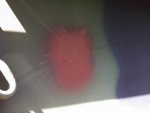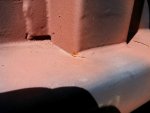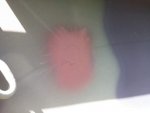I have done some spot treatment on my truck for old CARC paint about 4-6 months ago between March and May of 2015...

The above picture was done by taking 0 degree pressure washer at the flaking paint,
than using a drill with wire brush wheel to scrape the edges of spots,
than sprayed with Rust Oleum Rust Convertor with tar paint to seal out moisture, but they recommend to paint over with something else and not leave it alone (I said ok)
than sprayed with Rust Oleum rusty metal primer (that's the reddish rust color)
But...

The spots that I couldn't/didn't treat with wire brush because either it was in a tight corner, weird angle or I skipped high on CARC begun creeping rust from underneath.
begun creeping rust from underneath.
So I am asking all the experienced wolfs any advice, how can I stop that creeping rust from under that paint with out investing 500k on tumbler size of my house with steel balls... (I dont even know if that exist)
or
Getting high on CARC every 4-6 months... (which I might start to like however probably I should not)
Thank you in advance for responses...

The above picture was done by taking 0 degree pressure washer at the flaking paint,
than using a drill with wire brush wheel to scrape the edges of spots,
than sprayed with Rust Oleum Rust Convertor with tar paint to seal out moisture, but they recommend to paint over with something else and not leave it alone (I said ok)
than sprayed with Rust Oleum rusty metal primer (that's the reddish rust color)
But...

The spots that I couldn't/didn't treat with wire brush because either it was in a tight corner, weird angle or I skipped high on CARC
So I am asking all the experienced wolfs any advice, how can I stop that creeping rust from under that paint with out investing 500k on tumbler size of my house with steel balls... (I dont even know if that exist)
or
Getting high on CARC every 4-6 months... (which I might start to like however probably I should not)
Thank you in advance for responses...
Attachments
-
17.9 KB Views: 29





 but thank you for great tips.
but thank you for great tips.


